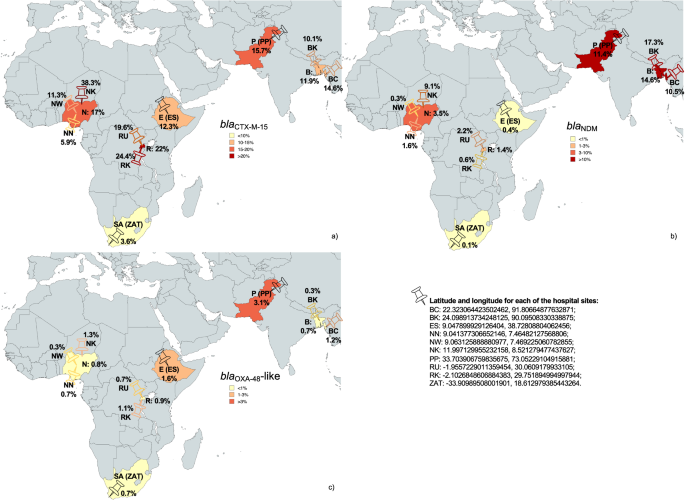Hospital surfaces serve as reservoirs for bacterial pathogens, contributing to nosocomial infections and mortality, especially in low- and middle-income countries (LMICs). The BARNARDS study aimed to assess the colonization of hospital surfaces and patient care equipment by Gram-negative bacteria (GNB) carrying antibiotic resistance genes (ARGs) in neonatal wards across LMICs. Here, we report on the prevalence, distribution, and transmission dynamics of extended-spectrum β-lactamases (ESBLs) and carbapenemases among GNB, and their potential association with neonatal sepsis.
Key Scientific Findings:
- PCR screening revealed a high prevalence of blaCTX-M-15, blaNDM, and blaOXA-48-like genes among GNB colonizing hospital surfaces and patient care equipment in 10 hospitals across six LMICs.
- MALDI-TOF MS identification and whole genome sequencing confirmed the presence of dominant clones of 𝘒𝘭𝘦𝘣𝘴𝘪𝘦𝘭𝘭𝘢 𝘱𝘯𝘦𝘶𝘮𝘰𝘯𝘪𝘢𝘦, 𝘌𝘯𝘵𝘦𝘳𝘰𝘣𝘢𝘤𝘵𝘦𝘳 𝘩𝘰𝘳𝘮𝘢𝘦𝘤𝘩𝘦𝘪, 𝘈𝘤𝘪𝘯𝘦𝘵𝘰𝘣𝘢𝘤𝘵𝘦𝘳 𝘣𝘢𝘶𝘮𝘢𝘯𝘯𝘪𝘪, 𝘚𝘦𝘳𝘳𝘢𝘵𝘪𝘢 𝘮𝘢𝘳𝘤𝘦𝘴𝘤𝘦𝘯𝘴, 𝘢𝘯𝘥 𝘓𝘦𝘤𝘭𝘦𝘳𝘤𝘪𝘢 𝘢𝘥𝘦𝘤𝘢𝘳𝘣𝘰𝘹𝘺𝘭𝘢𝘵𝘢carrying ARGs.
- 𝘚𝘛15 𝘒. 𝘱𝘯𝘦𝘶𝘮𝘰𝘯𝘪𝘢𝘦 was identified as a persistent clone colonizing surfaces over multiple occasions, with identical strains causing neonatal sepsis in Pakistan.
- Horizontal transmission of ARGs, particularly blaNDM, was evidenced by the genetic similarity between plasmids detected within 𝘌𝘯𝘵𝘦𝘳𝘰𝘣𝘢𝘤𝘵𝘦𝘳𝘢𝘭𝘦𝘴 from multiple hospital surfaces.
- ESBL- and carbapenemase-producing 𝘌𝘯𝘵𝘦𝘳𝘰𝘣𝘢𝘤𝘵𝘦𝘳𝘢𝘭𝘦𝘴 were frequently detected near sink drains, suggesting a hotspot for colonization.
- Diversity within species and co-occurrence of dominant sequence types (STs) of 𝘌. 𝘩𝘰𝘳𝘮𝘢𝘦𝘤𝘩𝘦𝘪 𝘢𝘯𝘥 𝘒. 𝘱𝘯𝘦𝘶𝘮𝘰𝘯𝘪𝘢𝘦 were observed, indicating complex transmission dynamics.
- Variability in GNB colonization was observed across countries and hospitals, emphasizing the need for individualized monitoring and intervention strategies.
- High prevalence of antibiotic resistance determinants and diversity of ARG-containing bacteria on hospital surfaces pose a significant threat to patient safety, warranting urgent assessment and improvement of infection prevention and control (IPC) practices.
Methodology:
- Environmental surfaces and patient care equipment from neonatal wards were sampled across 10 hospitals in LMICs.
- PCR screening for ESBLs and carbapenemases, MALDI-TOF MS identification, and whole genome sequencing were performed to characterize GNB carrying ARGs.
- Data analysis included assessment of prevalence, distribution, persistence of dominant clones, and transmission dynamics of antibiotic-resistant GNB.
- In conclusion, our study highlights the widespread colonization of hospital surfaces by antibiotic-resistant GNB carrying ESBLs and carbapenemases in LMICs. The identification of persistent clones and evidence of transmission networks between hospital wards and neonates with sepsis underscores the urgency for improved IPC practices and tailored guidelines to mitigate the threat of antimicrobial resistance in healthcare settings. Further research is needed to understand the impact of bacterial transmission events on neonatal sepsis and to develop targeted interventions to prevent nosocomial infections in LMICs.
